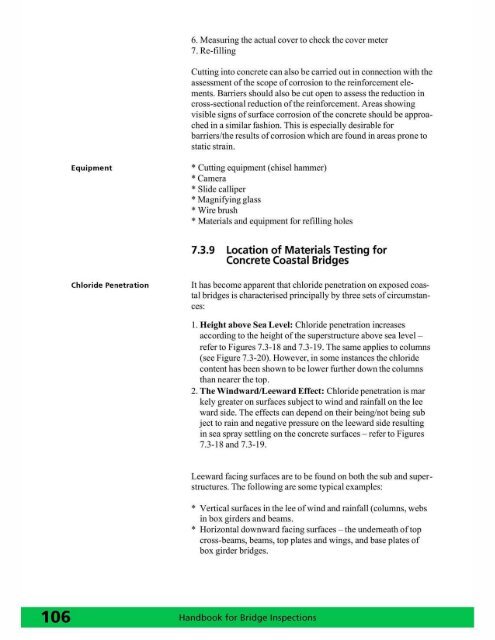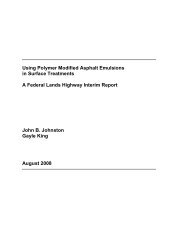Handbook for Bridge Inspections - TSP2
Handbook for Bridge Inspections - TSP2
Handbook for Bridge Inspections - TSP2
Create successful ePaper yourself
Turn your PDF publications into a flip-book with our unique Google optimized e-Paper software.
6. Measuring the actual cover to check the cover meter<br />
7. Re-filling<br />
Cutting into concrete can also be carried out in connection with the<br />
assessment of the scope of corrosion to the rei n<strong>for</strong>cement elements.<br />
Barriers should also be cut open to assess the reduction in<br />
cross-sectional reduction of the rein<strong>for</strong>cement. Areas showing<br />
visible signs of surface corrosion of the concrete should be approached<br />
in a similar fashion. This is especiall y desirable <strong>for</strong><br />
barrierslthe results of corrosion which are found in areas prone to<br />
static strain.<br />
Equipment<br />
* Cutting equipment (chisel hammer)<br />
* Camera<br />
* Slidc callipcr<br />
* Magnifying glass<br />
* Wire brush<br />
* Materials and equipment <strong>for</strong> refilling holes<br />
7.3.9 Location of Materials Testing <strong>for</strong><br />
Concrete Coastal <strong>Bridge</strong>s<br />
Chloride Penetration<br />
It has become apparent that chloride penetration on exposed coastal<br />
bridges is characterised principal ly by three sets of circumstances:<br />
I. Height above Sea Level: Chloride penetration increases<br />
according to the he igh t of the superstructure above sea level <br />
refer to Figures 7.3- 18 and 7.3- 19. The same applies to co lumns<br />
(see Figure 7.3-20). However, in some instances the chloride<br />
contem has been shown to be lower further down the columns<br />
than nearer the top.<br />
2. The Windward/Leeward Effect: Chl oride penetration is mar<br />
kely greater on surfaces subject to wind and rainfa ll on the lee<br />
ward side. The effects can depend on their being/not being sub<br />
ject to rain and negative pressure on the leeward side resu lting<br />
in sea spray settling on the concrete surfaces - refer to Figures<br />
7.3-18and 7.3-19.<br />
Leeward facing surfaces are to be found on both the sub and superstructures.<br />
The following are some typ ical examples:<br />
* Vertical surfaces in the lee of wi nd and ra infall (columns, webs<br />
in box gi rders and beams.<br />
* Horizo ntal downward fac ing surfaces - the undemeath of top<br />
cross-beams, beams, top plates and wings, and base plates of<br />
box girder bridges.
















